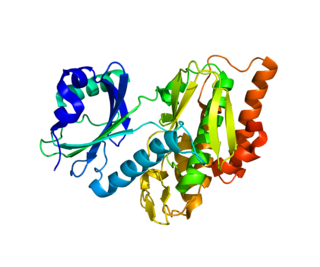
SCL-interrupting locus protein is a protein that in humans is encoded by the STIL gene. STIL is present in many different cell types and is essential for centriole biogenesis. This gene encodes a cytoplasmic protein implicated in regulation of the mitotic spindle checkpoint, a regulatory pathway that monitors chromosome segregation during cell division to ensure the proper distribution of chromosomes to daughter cells. The protein is phosphorylated in mitosis and in response to activation of the spindle checkpoint, and disappears when cells transition to G1 phase. It interacts with a mitotic regulator, and its expression is required to efficiently activate the spindle checkpoint.

Kinesin-like protein KIF22 is a protein that in humans is encoded by the KIF22 gene.

Kinesin-like protein KIF2C is a protein that in humans is encoded by the KIF2C gene.

Dual specificity protein kinase TTK also known as Mps1 is an enzyme that in humans is encoded by the TTK gene.

TRIO and F-actin-binding protein is a protein that in humans is encoded by the TRIOBP gene.

Motor neuron and pancreas homeobox 1 (MNX1), also known as Homeobox HB9 (HLXB9), is a human protein encoded by the MNX1 gene.

Cytoskeleton-associated protein 2 is a protein that in humans is encoded by the CKAP2 gene.

Aurora kinase C, also Serine/threonine-protein kinase 13 is an enzyme that in humans is encoded by the AURKC gene.

Y+L amino acid transporter 1 is a protein that in humans is encoded by the SLC7A7 gene.

Structural maintenance of chromosomes protein 4 (SMC-4) also known as chromosome-associated polypeptide C (CAP-C) or XCAP-C homolog is a protein that in humans is encoded by the SMC4 gene. SMC-4 is a core subunit of condensin I and II, large protein complexes involved in chromosome condensation.

MASTL is an official symbol provided by HGNC for human gene whose official name is micro tubule associated serine/threonine kinase like. This gene is 32,1 kbps long. This gene is also known as GW, GWL, THC2, MAST-L, GREATWALL. This is present in mainly mammalian cells like human, house mouse, cattle, monkey, etc. It is in the 10th chromosome of the mammalian nucleus. Recent studies have been carried on zebrafish and frogs. This gene encodes for the protein micro tubule associated serine/threonine kinase and its sub-classes.

Ras-related protein Rab-23 is a protein that in humans is encoded by the RAB23 gene. Alternative splicing occurs at this gene locus and two transcript variants encoding the same protein have been identified.

Condensin-2 complex subunit G2 (CAP-G2) also known as chromosome-associated protein G2 (CAP-G2) or leucine zipper protein 5 (LUZP5) is a protein that in humans is encoded by the NCAPG2 gene. CAP-G2 is a subunit of condensin II, a large protein complex involved in chromosome condensation. It interacts with PLK1 through its C-terminal region during mitosis

KIF1-binding protein, also known as Kinesin binding protein(KBP), is a protein that in humans is encoded by the KIAA1279 gene. The interaction of KBP with Kif15 is necessary for the localization of Kif15 to the microtubule plus-end at the spindle equator. Interaction between Kif15 and KBP is essential for the perfect alignment of chromosomes at the metaphase plate, and any defect in their interaction leads to delay in chromosomal alignment during mitosis. Anything that perturb the interaction of KBP and Kif15 can block the cells at mitosis, and hence it can be therapeutically used to control Kif15 upregulated cancer cells.

Myosin-XV is a protein that in humans is encoded by the MYO15A gene.

Serine/threonine-protein kinase haspin is an enzyme that in humans is encoded by the GSG2 gene.

Neural precursor cell expressed, developmentally down-regulated 1, also known as Nedd1, is a human gene and encodes the protein NEDD1.

Centrosomal protein of 120 kDa (Cep120), also known as coiled-coil domain-containing protein 100, is a protein that in humans is encoded by the CEP120 gene.

Cryptic protein, also cryptic family member 1 is a protein that in humans is encoded by the CFC1 gene.

Ras association domain family member 7 is a protein that in humans is encoded by the RASSF7 gene.





















